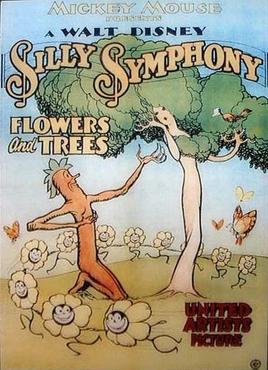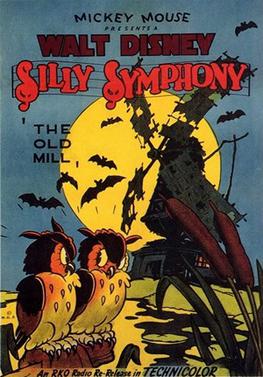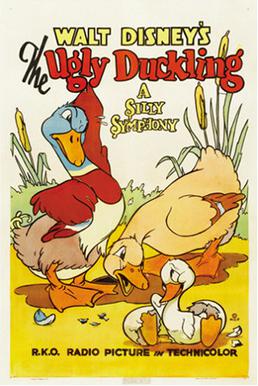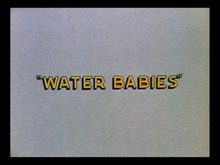
Flowers and Trees is a Silly Symphonies cartoon produced by Walt Disney, directed by Burt Gillett, and released to theatres by United Artists on July 30, 1932. It was the first commercially released film to be produced in the full-color three-strip Technicolor process after several years of two-color Technicolor films. The film was a commercial and critical success, winning the first Academy Award for Best Cartoon Short Subject.

The Old Mill is a Silly Symphonies cartoon produced by Walt Disney Productions, directed by Wilfred Jackson, scored by Leigh Harline, and released theatrically to theatres by RKO Radio Pictures on November 5, 1937. The film depicts the natural community of animals populating an old abandoned windmill in the country, and how they deal with a severe summer thunderstorm that nearly destroys their habitat. It incorporates the song "One Day When We Were Young" from Johann Strauss II's operetta The Gypsy Baron.

Toby Tortoise Returns is an animated Technicolor cartoon in Walt Disney's Silly Symphonies series, directed by Wilfred Jackson. It is a sequel to the 1935 short The Tortoise and the Hare, and premiered on August 22, 1936.
Elmer Elephant is a Silly Symphony cartoon short produced by The Walt Disney Company, directed by Wilfred Jackson and released on March 28, 1936.
Music Land is a Silly Symphony animated Disney short released in 1935.

The Ugly Duckling is an animated short film by Walt Disney, based on the 1843 fairy tale "The Ugly Duckling" by Hans Christian Andersen. The film was directed by Jack Cutting and Clyde Geronimi, and released in theaters on April 7, 1939. Music was composed by Albert Hay Malotte, who was uncredited for the film. The animated short was first distributed by RKO Radio Pictures, and was shown with Love Affair.
The Ugly Duckling is an animated black-and-white cartoon released by Walt Disney in 1931 as part of the Silly Symphonies series. This cartoon was later remade into a color version released in 1939, which follows the original Andersen story much more faithfully. This gives The Ugly Duckling the unique distinction of being the only Silly Symphony to be made twice. This film was then sold to reach about 4,000 dollars per month at the most profit, because it slowly climbed up the scale of growth.

The Country Cousin is a Walt Disney animated short film released on October 31, 1936 by United Artists. The winner of an Oscar at the 9th Academy Awards for Best Animated Short Film, the film was produced by Walt Disney, directed by Wilfred Jackson, and animated by Art Babbitt and Les Clark. As is true for most cartoons in the Silly Symphonies series, The Country Cousin was built around a musical score, which was written by Leigh Harline. The film's story was based on one of Aesop's Fables, The Town Mouse and the Country Mouse. It was accompanied by a storybook for young children, which was common for many of the Silly Symphonies.
The Grasshopper and the Ants is a 1934 American animated short film produced by Walt Disney Productions and released by United Artists. Part of the Silly Symphonies series, the film is an adaptation of The Ant and the Grasshopper, one of Aesop's Fables. It was directed by Wilfred Jackson and stars Pinto Colvig as the voice of the grasshopper Hop.
Mother Pluto is a Silly Symphonies cartoon released on November 14, 1936, directed by Wilfred Jackson. The cartoon features Pluto.

Three Blind Mouseketeers is a Silly Symphonies cartoon based on the nursery rhyme Three Blind Mice and the 1844 novel The Three Musketeers by Alexandre Dumas. Directed by Dave Hand and Jack Cutting, it stars Billy Bletcher.
The Flying Mouse is a Silly Symphonies cartoon produced by Walt Disney, directed by David Hand, and released to theatres by United Artists on July 14, 1934. The use of color here was rather innovative as it is set during the course of a single day.

The Robber Kitten is a 1935 Walt Disney Silly Symphonies cartoon, directed by David Hand.
Birds of a Feather is a Silly Symphonies animated Disney short film. It was released on February 10, 1931, by Columbia Pictures.
Springtime is a Silly Symphonies animated Disney short film. It was released in 1929. It was the third Silly Symphonies film to be produced, just five days before the 1929 Stock Market Crash. The short's copyright was renewed in 1957, so it will enter the US public domain on January 1, 2025.
The Busy Beavers is a 1931 Silly Symphonies animated film, directed by Burt Gillett.
Peculiar Penguins is a Silly Symphonies animated Disney short film. It was released in 1934. The song played during the cartoon is called "The Penguin Is a Very Funny Creature", by Leigh Harline.

Woodland Café is a Silly Symphonies animated Disney short film. It was filmed in Technicolor and released by United Artists in 1937 and was re-issued by RKO Radio Pictures in 1948. While it contained no on-screen credits, Wilfred Jackson was the director and Leigh Harline was the musical director.
Lullaby Land is a Silly Symphonies animated Disney short film released in 1933. The quilt from Lullaby Land inspired the garden section of the Storybook Land Canal Boats ride at Disneyland California.

Farmyard Symphony is a 1938 Silly Symphonies animated short film. It can be seen as a precursor to Fantasia due to using various pieces of classical music in one short. The film was directed by Jack Cutting and produced by Walt Disney.









